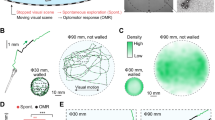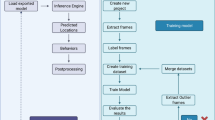Abstract
Neuroactive small molecules are indispensable tools for treating mental illnesses and dissecting nervous system function. However, it has been difficult to discover novel neuroactive drugs. Here, we describe a high-throughput, behavior-based approach to neuroactive small molecule discovery in the zebrafish. We used automated screening assays to evaluate thousands of chemical compounds and found that diverse classes of neuroactive molecules caused distinct patterns of behavior. These 'behavioral barcodes' can be used to rapidly identify new psychotropic chemicals and to predict their molecular targets. For example, we identified new acetylcholinesterase and monoamine oxidase inhibitors using phenotypic comparisons and computational techniques. By combining high-throughput screening technologies with behavioral phenotyping in vivo, behavior-based chemical screens can accelerate the pace of neuroactive drug discovery and provide small-molecule tools for understanding vertebrate behavior.
This is a preview of subscription content, access via your institution
Access options
Subscribe to this journal
Receive 12 print issues and online access
$259.00 per year
only $21.58 per issue
Buy this article
- Purchase on Springer Link
- Instant access to full article PDF
Prices may be subject to local taxes which are calculated during checkout





Similar content being viewed by others
References
Ayd, F.J. & Blackwell, B. Discoveries in Biological Psychiatry (Lippincott, Philadelphia, 1970).
Agid, Y. et al. How can drug discovery for psychiatric disorders be improved? Nat. Rev. Drug Discov. 6, 189–201 (2007).
Stockwell, B.R. Chemical genetics: ligand-based discovery of gene function. Nat. Rev. Genet. 1, 116–125 (2000).
Lehár, J., Stockwell, B.R., Giaever, G. & Nislow, C. Combination chemical genetics. Nat. Chem. Biol. 4, 674–681 (2008).
Catterall, W.A. Cooperative activation of action potential Na+ ionophore by neurotoxins. Proc. Natl. Acad. Sci. USA 72, 1782–1786 (1975).
Akera, T. Membrane adenosinetriphosphatase: a digitalis receptor? Science 198, 569–574 (1977).
Hert, J., Keiser, M., Irwin, J., Oprea, T. & Shoichet, B. Quantifying the relationships among drug classes. J. Chem. Inf. Model. 48, 755–765 (2008).
Keiser, M.J. et al. Relating protein pharmacology by ligand chemistry. Nat. Biotechnol. 25, 197–206 (2007).
Gnerre, C. et al. Inhibition of monoamine oxidases by functionalized coumarin derivatives: biological activities, QSARs, and 3D-QSARs. J. Med. Chem. 43, 4747–4758 (2000).
Santana, L. et al. Quantitative structure-activity relationship and complex network approach to monoamine oxidase A and B inhibitors. J. Med. Chem. 51, 6740–6751 (2008).
Bajgar, J. Organophosphates/nerve agent poisoning: mechanism of action, diagnosis, prophylaxis, and treatment. Adv. Clin. Chem. 38, 151–216 (2004).
Davis, K.L. et al. Physostigmine: improvement of long-term memory processes in normal humans. Science 201, 272–274 (1978).
Thase, M.E., Trivedi, M.H. & Rush, A.J. MAOIs in the contemporary treatment of depression. Neuropsychopharmacology 12, 185–219 (1995).
Foley, J.E. et al. Rapid mutation of endogenous zebrafish genes using zinc finger nucleases made by Oligomerized Pool ENgineering (OPEN). PLoS ONE 4, e4348 (2009).
Meng, X., Noyes, M.B., Zhu, L.J., Lawson, N.D. & Wolfe, S.A. Targeted gene inactivation in zebrafish using engineered zinc-finger nucleases. Nat. Biotechnol. 26, 695–701 (2008).
Doyon, Y. et al. Heritable targeted gene disruption in zebrafish using designed zinc-finger nucleases. Nat. Biotechnol. 26, 702–708 (2008).
Rovida, C. & Hartung, T. Re-evaluation of animal numbers and costs for in vivo tests to accomplish REACH legislation requirements for chemicals — a report by the Transatlantic Think Tank for Toxicology (t4). ALTEX 26, 187–208 (2009).
Holt, A. & Palcic, M.M. A peroxidase-coupled continuous absorbance plate-reader assay for flavin monoamine oxidases, copper-containing amine oxidases and related enzymes. Nat. Protocols 1, 2498 (2006).
James, C.A., Weininger, D. & Delany, J. Daylight theory manual (Daylight Chemical Information Systems, 1995).
Oprea, T.I. Chemoinformatics in Drug Discovery. (Wiley, Weinheim, Germany, 2005).
Acknowledgements
We thank E. Scolnick, M. Granato, J. Dowling, D. Milan, C. Felts, J. Rihel, A. Schier and members of our research groups for encouragement and advice. This work was supported by US National Institutes of Health training grant HL07208 (D.K.) and grants NS063733 (R.T.P.), MH085205 (R.T.P.), MH086867 (R.T.P.) and GM71896 (B.K.S. and J. Irwin), the National Sciences and Engineering Council of Canada (J.B.), the Canadian Institutes of Health Research (J.B.), the Max Kade Foundation (C.L.) and the Stanley Medical Research Institute (S.J.H.).
Author information
Authors and Affiliations
Contributions
D.K. designed and performed the research, analyzed the data and wrote the manuscript. J.B., C.L., R.W. and B.S. analyzed and interpreted the data and contributed to the manuscript. C.Y.J.C., R.M., D.H. and S.K. performed experiments. A.A.W. contributed to hardware design. S.J.H. and C.A.M. contributed reagents. R.T.P designed the research, analyzed the data and wrote the manuscript. All authors contributed to data interpretation and commented on the manuscript.
Corresponding authors
Ethics declarations
Competing interests
The authors declare no competing financial interests.
Supplementary information
Supplementary Text and Figures
Supplementary Figures 1–5, Supplementary Tables 1–2 and Supplementary Methods (PDF 1464 kb)
Supplementary Movie 1
Movie of the PMR in zebrafish embryos in a petri dish at low magnification. (MOV 262 kb)
Supplementary Movie 2
Movie of the PMR at higher magnification. (MOV 455 kb)
Supplementary Movie 3
Movie of the PMR behavior at 30 hpf, showing that animals do not normally respond to a second pulse of light. (MOV 365 kb)
Supplementary Movie 4
Movie of the robotic screening hardware delivering light pulses to the individual wells of a 96-well plate. (MOV 594 kb)
Supplementary Movie 5
Movie of an untreated control well in the ETR assay. (MOV 444 kb)
Supplementary Movie 6
Movie of the slow to relax (STR) phenotype in a well treated with STR-1 during the ETR assay. (MOV 447 kb)
Rights and permissions
About this article
Cite this article
Kokel, D., Bryan, J., Laggner, C. et al. Rapid behavior-based identification of neuroactive small molecules in the zebrafish. Nat Chem Biol 6, 231–237 (2010). https://doi.org/10.1038/nchembio.307
Received:
Accepted:
Published:
Issue Date:
DOI: https://doi.org/10.1038/nchembio.307
This article is cited by
-
Novel use of FDA-approved drugs identified by cluster analysis of behavioral profiles
Scientific Reports (2022)
-
Long lasting anxiety following early life stress is dependent on glucocorticoid signaling in zebrafish
Scientific Reports (2022)
-
Identifying Behavioral Response Profiles of Two Common Larval Fish Models to a Salinity Gradient
Archives of Environmental Contamination and Toxicology (2022)
-
Evaluation of the effects of acetylcholinesterase inhibitors in the zebrafish touch-evoked response: quantitative vs. qualitative assessment
Environmental Sciences Europe (2020)
-
Hypo- or hyperactivity of zebrafish embryos provoked by neuroactive substances: a review on how experimental parameters impact the predictability of behavior changes
Environmental Sciences Europe (2019)



